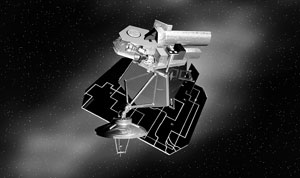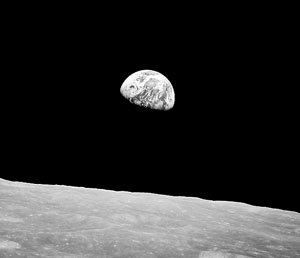Looking up at the new moon, Leonardo da Vinci imagined something that no one before him had. The sight of the “old moon in the new moon’s arms” had long inspired poets even as it confounded scientists. Looking between the horns of the crescent moon, da Vinci hypothesised that the faint ashen glow that lit even the dark parts of the orb was in fact the reflection of the earth’s own light.
His theory was confirmed when astronauts landed on the moon and they marvelled at an Earth that shone bright on the lunar horizon – 50 times brighter than the full moon. Now, da Vinci’s discovery is being put to use by scientists who are studying the ‘earthshine’ that bounces back from the moon. The data helps them outline the parameters for how earth itself would look like from a great distance; a finding that is key to the search for the holy grail of astrobiology - earthlike planets.
 |
| NASA's Deep Impact spacecraft. (Credit: NASA/JPL-Caltech) |
Dr. Tilak Hewagama is an astrophysicist who has been attached to the University of Maryland as an Assistant Research Scientist from 1999. In that time he has worked with the Challenger Centre for Space Science Education, the Smithsonian Institution and the NASA/Goddard Space Flight Centre. Over the course of a long career, Tilak has studied things like sunspots and the direction of winds on Saturn’s moon Titan.
Earthshine remains, if not the most effective then at least the most affordable way of studying the Earth, says Tilak. Of late, however, some of his work has been with the EPOXI mission, specifically the EPOCH component of it. EPOXI is an acronym binding two science investigations: the Extrasolar Planet Observation and Characterization and Deep Impact extended Investigation. The satellite itself goes by the name of Deep Impact.
Tilak has had the luxury of looking at the gleanings of the Deep Impact satellite. Three years ago, in May 2008, it took a set of pictures from a distance of roughly one astronomical unit out. In the image, the moon was captured as it passed directly between the spacecraft and the earth. Here is our planet as it looks from a great distance away. Scientists like Tilak have used what they saw to help build instruments and devise methods of looking at earth-like planets even in other galaxies. But should we find one, what do we look for next? Signs of life.
Here the action moves back to land. Earth bound biologists have made some startling discoveries in recent decades. The existence of extremophiles – under crushing pressure at the bottom of the oceans or in the searing temperatures of thermal vents, in the salty brine of the Great Salt Lake or in the calcium chloride laced icy pools of Antarctica - has proved that microbial life can thrive in the harshest of conditions. There is also growing support for the idea that extremophiles were among the earliest living things on Earth. “Everywhere we look on the earth, we see life where we wouldn’t expect to see it,” says Tilak marvelling.

|
| Dr. Tilak Hewagama |
As scientists continue to be amazed by the resilience of life, it has led them back to examine environments within the Solar System that were previously dismissed as being too hostile. It’s the reason why the discovery of methane on Mars inspired such excitement. On Earth, methane is fairly common and is produced by volcanoes but also by the process of enteric fermentation in the guts of ruminants. (It’s a delicate way of saying that the constant belching and farting of large numbers of cows and sheep has made an impression on our atmosphere). In addition, as biomass breaks down it releases methane. So when Tilak and the NASA team published the paper “Absolute Measurements of Methane on Mars: Evidence for Strong Release in Northern Summer 2003” in 2009, it immediately led to speculation of whether life could be found on Mars.
The only problem lies in verifying the findings and then in separating the methane produced by geochemical activity (some of the plumes were discovered at the base of a volcano on the Martian surface) from gas produced by the living organisms like bacteria.
The answer to that question might come this year with the launch of Nasa's Mars Science Laboratory (MSL) rover. It will carry instruments that can ferret out the true origin of the gas. It’s an exciting time to be working in the field – “we may be on the threshold of true astrobiology,” says Tilak.
Currently, sending a rover to scout out territory is only possible for planets within our own solar system, and these undertakings are still depressingly expensive. Using telescopes, Tilak has been throwing his net further afield, scouring far more distant planets for earth like qualities. Using theories like the Doppler effect and techniques like Spectrometry he’s trying to first identify and then bypass the enormous distances to form some idea of what those extra-solar planets are like – what gases their atmosphere contains or how large their mass is. It’s a study that he could easily devote the rest of his career too.
 |
| Earthrise (Credit: NASA) |
I meet Tilak during the course of a brief visit to Sri Lanka. He is here to attend a cousin’s wedding and to spend time with his mother before he returns to the U.S.A. The son of a banker, he says he has his mother to thank for his interest in astronomy. She spent a great deal of time reading books and even encyclopaedias to a young Tilak. The presence of Arthur C. Clarke on the island and a robust young astronomers club combined with the excitement of the moon landings to inspire Tilak to become an astrophysicist and to go into research. He left to study abroad when he was 24. Equipped with a B.Sc from the University of Colombo, he went on to study for his M.Sc at the University of Wyoming and then did his PhD at the University of Maryland where he has remained ever since.
We’re discussing his thesis on sunspots when the end of the world comes up. Alarmists have foretold the coming solar maximum will wreck havoc on the planet but solar maximums and minimums are simply a part of the ongoing solar cycle. Solar maxima can be intense as in 1958, or barely detectable, as in 1805, and it’s difficult to predict which kind we’re in for. “There are real issues related to solar maximum, but we’ve been through many solar maximums,” says Tilak reassuringly. Increased solar activity is marked by the appearance of many sunspots and is likely to result in more communication disturbances. “You can also expect to see more storms, or maybe fewer but stronger storms,” he cautions adding it might be difficult to judge how much of it has to do with climate change.
His take on the Mayan doomsday prediction is that those very smart people simply decided that they couldn’t reliably foretell the future past this point, and so they quit while they were ahead. “We are the people at that edge,” he says adopting a serious tone, and then bursting into laughter unbends enough to give me the good news: “the world will not come to an end, we’ll see 2013.” |




